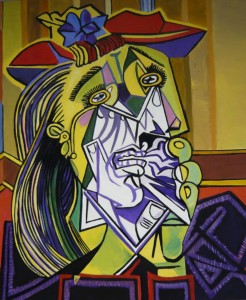Weeping Woman, Paris, October 26 1937 by Pablo Picasso, copy by Derek Kosbab 2010.
Weeping Woman (Dora), (60 х 49 cm, 23 ⅝ х 19 ¼ inches) is an oil on canvas painted by Pablo Picasso in 1937. Picasso was intrigued with the subject, and revisited the theme numerous times that year. This painting was the final and most elaborate of the series. It has been in the collection of the Tate Gallery in London since 1987.
One of the earlier versions was stolen from the National Gallery of Victoria in Melbourne, Australia. A famous event in the history of the gallery was the theft of Pablo Picasso’s painting “The Weeping Woman” in 1986 by a person or group who identified themselves as the “Australian Cultural Terrorists”. The group took the painting to protest the perceived poor treatment of the arts by the state government of the time and sought as a ransom the establishment of an art prize for young artists. The painting was returned in a railway locker a week later.
The series are studies of how much pain can be communicated by a human face. It has the features of a specific person, Dora Maar, whom Picasso described as “always weeping”. She was in fact his close collaborator in the time of his life when he was most involved with politics. The Weeping Woman series is regarded as a thematic continuation of the tragedy depicted in Picasso’s epic painting Guernica. In focusing on the image of a woman crying, the artist was no longer painting the effects of the Spanish Civil War directly, but rather referring to a singular universal image of suffering.
$1,000.00 via PayPal
Acrylic on canvas: 600mm x 500mm
